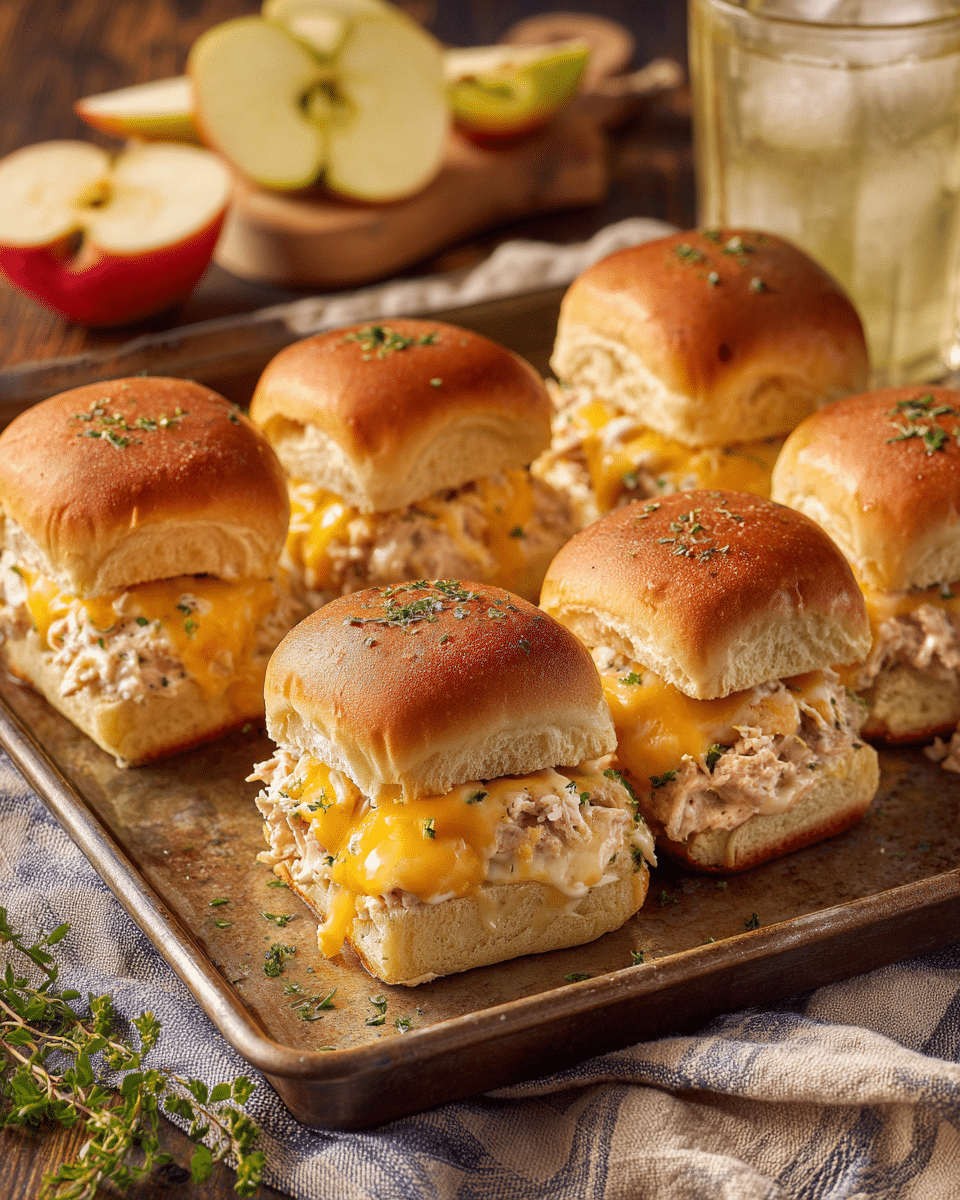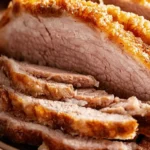Tuna Melt Sliders are a quick, warm, and cheesy sandwich solution perfect for back-to-school lunches or weeknight dinners. They combine the creamy comfort of classic tuna salad with the gooey goodness of melted cheese, all tucked inside soft slider buns. These bite-sized sandwiches are baked until golden and toasty, making them an ideal grab-and-go meal for busy families.
FULL RECIPE
Ingredients
- 2 cans (5 oz each) tuna in water, drained
- ½ cup mayonnaise
- 1 tablespoon Dijon mustard (optional)
- ½ cup finely chopped celery
- ¼ cup finely chopped red onion
- Salt and pepper, to taste
- 1 cup shredded cheddar cheese (or slices, if preferred)
- 12 slider buns or Hawaiian rolls
- 2 tablespoons unsalted butter, melted
- 1 teaspoon garlic powder
- 1 teaspoon dried parsley (optional)
Directions
- Preheat the oven to 350°F (175°C).
- In a medium bowl, combine the drained tuna, mayonnaise, Dijon mustard (if using), celery, red onion, salt, and pepper. Mix until well combined.
- Slice the slider buns in half horizontally, keeping them attached if possible to make assembly easier.
- Place the bottom halves in a baking dish or on a parchment-lined sheet pan.
- Spread the tuna mixture evenly over the bottom halves.
- Sprinkle or layer the shredded or sliced cheddar cheese over the tuna filling.
- Place the top halves of the buns back on.
- In a small bowl, mix the melted butter with garlic powder and parsley. Brush this mixture over the tops of the buns.
- Cover loosely with foil and bake for 10 minutes.
- Remove foil and bake uncovered for another 5–7 minutes, or until the tops are golden brown and the cheese is melted.
- Serve warm.
Nutrition Facts
- Calories: 210
- Protein: 11g
- Total Fat: 13g
- Saturated Fat: 4g
- Carbohydrates: 14g
- Sugars: 3g
- Dietary Fiber: 1g
- Cholesterol: 25mg
- Sodium: 370mg
- Calcium: 120mg
- Iron: 1.1mg
- Potassium: 130mg
Why Tuna Melt Sliders Are a Great Back-to-School Lunch Option
Tuna melt sliders are a smart solution for busy school mornings or hectic weeknight dinners. Compact and satisfying, they are easy to prepare in batches and offer the perfect mix of protein, carbs, and fats to fuel active kids throughout the day. Unlike cold sandwiches that can become soggy or bland by lunchtime, these sliders stay flavorful and comforting even when cooled. Their warm, cheesy interior and golden tops also provide a homemade touch that can help picky eaters feel more satisfied and excited about their lunch.
Nutritional Value and Health Benefits
Tuna is a nutrient-dense protein source, rich in omega-3 fatty acids, vitamin D, and essential minerals like selenium. These nutrients support brain development and cognitive function, making tuna an excellent choice for school-aged children. The cheese adds calcium and protein, while the use of whole grain or fiber-rich buns can boost digestive health. Even with their indulgent taste, tuna melt sliders can be made with health-conscious ingredients to support a well-balanced diet when served with fruits or vegetables on the side.
Tips for Choosing the Best Tuna
The type of tuna used can greatly impact the flavor and nutrition of the sliders. Canned tuna in water is a leaner option, while tuna in oil delivers a richer texture. Light tuna (usually skipjack) tends to have less mercury than albacore (white tuna), making it a safer option for frequent consumption, especially for children. Always drain the tuna well before mixing it into the filling to avoid watery sliders. For those who prefer fresh tuna, leftovers from grilled or baked fish can also be flaked and used in place of canned versions.
Perfect Cheeses for Melting and Flavor
Cheese selection plays a key role in creating the gooey, satisfying texture of a good tuna melt slider. Sharp cheddar is a traditional choice due to its bold flavor and smooth melting qualities. However, other melt-friendly options like Swiss, provolone, Monterey Jack, or mozzarella can offer unique flavor profiles. A blend of cheeses can also be used for added depth. For those looking to cut fat or sodium, low-fat cheese or plant-based cheese alternatives can still produce a delicious melt with less guilt.
Slider Buns: Soft, Toasty, and Just the Right Size
Slider buns provide the ideal base for these mini sandwiches. Soft and slightly sweet rolls like Hawaiian buns offer a nice contrast to the savory tuna filling. Whole wheat or multigrain buns can be used for added fiber and nutrition. It’s important to choose buns that are sturdy enough to hold the tuna mixture without getting soggy during baking. Toasting the buns slightly before assembling can help preserve their texture. Keeping the buns intact while slicing and layering helps the sliders stay together when served or packed.
Creative Variations to Try
Tuna melt sliders are incredibly versatile and can be easily customized to suit different tastes and dietary needs. Add-ins like chopped pickles, olives, hard-boiled eggs, or capers can enhance the flavor. Spice lovers might enjoy a bit of sriracha or diced jalapeños mixed into the tuna salad. You can also experiment with different spreads like pesto, hummus, or mustard on the buns. For a Mediterranean twist, add crumbled feta and sun-dried tomatoes. These small tweaks can transform the classic slider into something entirely new and exciting.
Serving Suggestions for Balanced Meals
To turn tuna melt sliders into a well-rounded meal, pair them with fresh produce or wholesome sides. Sliced apples, carrot sticks, or a small fruit salad can balance the richness of the melted cheese and tuna. A side of yogurt, veggie chips, or a green salad with vinaigrette also complements the sliders well. For an after-school snack or dinner, a warm bowl of tomato soup pairs beautifully with the sliders, echoing the classic grilled cheese-and-soup combo in a new form.
Meal Prep and Storage Advice
Tuna melt sliders can be prepped in advance, making them ideal for meal planning. The tuna mixture can be prepared up to two days ahead and stored in an airtight container in the refrigerator. Fully assembled sliders can be refrigerated overnight and baked fresh in the morning. If you want to freeze them, wrap the unbaked sliders individually in foil and store in a freezer-safe bag. When ready to serve, bake from frozen, adding a few extra minutes to the cooking time. Always store leftovers in the fridge and reheat in the oven or toaster oven to preserve texture.
Packing Sliders for School Lunches
For kids taking these sliders to school, allow them to cool slightly after baking to prevent condensation before packing them into lunch containers. Using insulated food jars or wrapping in foil with a heat pack can help keep them warm until lunch. Alternatively, they can be eaten at room temperature if prepped in the morning. Including a small napkin or divider helps prevent the sliders from getting squished or soggy by other lunch items.
Advertisement
Adapting for Dietary Restrictions
Tuna melt sliders can be adapted for various dietary needs without losing their appeal. For gluten-free diets, use certified gluten-free slider buns. Dairy-free versions can be made with vegan cheese and mayo alternatives. For lower sodium, choose tuna packed with no added salt and use low-sodium cheese. Vegetarians can replace tuna with mashed chickpeas or a plant-based tuna substitute, creating a similar texture and flavor profile. These swaps ensure that everyone in the family, regardless of dietary preferences, can enjoy a version of this satisfying comfort food.
Conclusion
Tuna melt sliders are a flavorful, kid-approved solution for busy school days and family meals. With their irresistible combination of creamy tuna salad, melty cheese, and golden slider buns, they offer both convenience and comfort. Whether served fresh out of the oven or packed for lunch, these sliders are versatile, easy to customize, and full of nutrients. From ingredient tweaks to storage hacks, there are endless ways to tailor this recipe to fit your needs.






